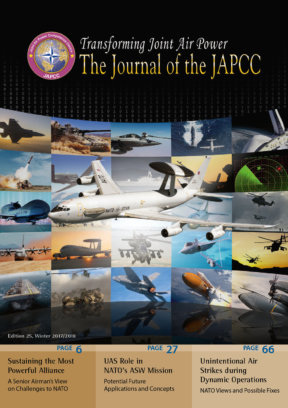Background and Introduction
The resurgence of Russian Federation Navy (RFN) submarine activity in the past few years has stimulated a response action from the Alliance. At both the 2014 Wales and 2016 Warsaw NATO Summits, Anti-Submarine Warfare (ASW) was identified as a crucial focus area which the Alliance must address to ensure it maintains its advantage and freedom of movement in the maritime domain. Many documents have cited NATO’s decreasing ASW capability and capacity, mostly due to the rapid decline of RFN submarine operations, which from the early 1990s until recently had nearly ceased. Furthermore, following the Cold War, NATO adopted a more expeditionary strategic view, causing many former ASW resources to be re-aligned to support other functions, many of which were out of the European theatre. The pendulum has recently begun to shift back, as acceptance of this challenge is growing in both the military and political spheres.
The Smart Defense initiative following the Wales Summit stimulated an intriguing line of thought. As operations in the air domain have relied heavily on unmanned and remotely operated systems for the last three NATO operations, what role do unmanned systems above, on and below the ocean’s surface have in NATO’s ASW mission? This article will explore the role that Unmanned Air Systems (UAS) serve today, as well as offer insight into potential future applications.
Benefits of UAS over Manned Systems
In general, unmanned systems have the following characteristics which can be distinct from manned systems, as expressed by Dr. Kevin LePage, Principal Scientist and Cooperative ASW Programme Manager at NATO’s Centre for Maritime Research and Experimentation:1
- force multiplier, integration with other systems and capabilities above and below the surface without the overhead of training a manned crew;
- improved endurance;
- operations in degraded/denied environments – greater risk threshold than manned systems;
- higher proportion of platform dedicated to payload;
- modularity;
- scalability;
- potentially lower unit cost than ‘equivalent’ manned platform.
Specific to ASW, this means an unmanned system could conduct certain time-consuming functions, such as loitering in a designated search location to monitor the ocean and conduct initial detection of a submarine moving through the area. This specific function has consumed a significant amount of the life-span of manned systems, such as the P-3 Orion series Maritime Patrol Aircraft (MPA), yet remains the most critical link in the ASW kill chain, as it is hard to engage a submarine with a torpedo if you have not yet determined its location. However, in the role of initial acoustic detection of a submarine and subsequent monitoring of its movement, sufficient bandwidth to support off-board acoustic processing remains a technical challenge, but research in this area is ongoing. Furthermore, persistent multi-sensor coverage provided by a single UAS can then cue in a manned system to conduct the next level of submarine prosecution, be it continued tracking or engagement with torpedoes.
Role of Larger Unmanned Systems
Larger UAS airframes, such as the US Navy’s MQ-4 Triton, are already serving in mutually supporting roles with other manned ASW platforms. However, the Triton’s sensor suite is better suited for other types of collection. Its method of detecting a submarine is limited to detection of any signals emitted or via radar should the submarine expose its periscope, snorkel or fully surface. The Triton is designed to work in concert with the P-8 Poseidon due to its limited ability to support purely ASW functions (such as acoustic processing or torpedo carriage).
However, these limitations to the Triton’s ASW capability reveal how a different type of unmanned system could actually better fill the role. The Global Hawk airframe (around which the Triton is designed) already has the payload and endurance to serve well here. The sensors would need to be adapted to specific ASW detection sensors. These new sensors could be a new type of undersea imaging system developed as a follow-on capability to the Littoral Airborne Sensor Hyperspectral (LASH)2, underwater laser imaging, or even an acoustic processor which interfaces with other sea-based or bottom mounted sensors. Currently, acoustic data on submarines is traditionally generated from sonobuoys launched from aircraft. This concept requires a large airframe capable of carrying and delivering at times more than 100 sonobuoys. The weight and carriage requirements make UAS use as a ‘sonobuoy truck’ unlikely, therefore other methods of leveraging off-board detection sensors must be explored.
Concept of Smaller Networked Systems
Smaller tactical UAS, such as Scan Eagle, are being deployed from many nations’ ships to serve in an Intelligence Surveillance Reconnaissance (ISR) role supporting the development of the maritime picture. As the case with the Triton, these tactical UAS have a limited ASW role, mostly in visual detection of submarines. However, should their sensor payload be changed out with a sensor capable of tracking a submarine (such as magnetic anomaly detection or other tracking sensor), they could provide an invaluable service in the tracking function and reduce flight hours required from MPA and ASW helicopters.
Furthermore, smaller, networked systems open up an interesting range of possibilities. In 2017, the US DoD launched 103 PERDIX micro-drones and demonstrated their ability to operate as a single entity, reorganizing their own formation to accomplish a set of missions and spatially arranging themselves to account for loss or failure of some of the drones to maintain coverage and accomplishing the mission.3 This concept is readily adaptable to an ASW role against a dynamic and evasive target.
Consider the Aqua-Quad. This small quad-copter drone is powered by solar cells providing a three month duration, and it has the ability to land on the ocean, deploy a small acoustic sensor below the surface, retrieve that sensor and lift off to reposition itself.4 In testing, it has proven capable of operating in 14 feet seas (4.3 m) despite its seemingly fragile frame.5 Extrapolating the concept of multiple networked drones self-synchronizing to perform a set of mission tasks, one can envision a fleet of Aqua-Quads serving both the initial detection and long duration tracking function.
A formation of these systems could be set across a known submarine transit area, such as a geographic choke point, with acoustic sensors deployed and solar batteries being charged while they wait and monitor. Upon detection of a submarine, the formation then re-organizes itself to surround the submarine, ensuring that multiple elements always remain ahead of the direction of travel to allow other elements time to reposition or to be prepared to adapt to a change in submarine course. A network of 25 or so of these systems could maintain proper tracking geometry even on evasive submarines as outlined in the notional diagrams in Figures 1–3 on the preceding pages.
There are a few technical challenges to this vision. First, the network must be able to communicate amongst itself to effectively organize. Secondly, the network must be able to communicate to an off-board command & control (C2) element to inform of the presence and movement of the submarine so a decision can be made regarding the next step of prosecution. Thirdly, the network must be able to communicate with off-board sensors as well, even unmanned systems operating on above and below the surface. This requires the development of a robust communications network. NATO’s Centre for Maritime Research and Experimentation in La Spezia, Italy, is focused on exploring solutions to this challenge for undersea systems, as the water provides some challenges to data transmission not seen in airborne linked networks.
To address the ability of these types of unmanned systems to communicate outside their local network, a new type of data transmission might be required. Dr. Wolfgang Griethe and Dr. Markus Knapek discussed the potential for optical datalinks and their applications for use by unmanned systems. They conclude that a compact micro-laser datalink terminal might be a viable solution to enhance airborne communications.6 In the case of the quad-copter above, building one of these into each of the individual platforms is not necessary, rather a separate type of unmanned system, such as a long duration UAS, could orbit overhead the swarm as part of their local communications network and then further disseminate information via an optical datalink to ashore or afloat C2 nodes.
Although this article is using the aqua-quad as an example of a type of technology which could be leveraged in this manner, it is not recommending procurement of one particular system or design over another. Research would need to be conducted into the best design model which captures this potential. As an example of other types of airframes which could serve this function, the MQ-8 Fire Scout could be further adapted with a dipping sonar and torpedo delivery capability, similar to the function manned ASW helicopters perform today, while being remotely piloted from the ship in the same manner it is flown for its ISR mission. Furthermore, the diagrams on submarine tracking in Figures 2–4 are notional, and once a system was constructed, detailed analysis would be required to develop tactics for optimal organization and patterns for various submarine speed and depth regimes.
Conclusion
Unmanned systems technology offers potential applications for use in the ASW mission area. Although there are some systems in existence today, most of their sensors are directed at an intelligence-gathering mission and have limited direct application to ASW, although innovative use of tactics to exploit sensor capability should continue to be explored. However, the future is promising for development of unmanned systems which are specifically devoted to the ASW mission. ASW as a mission requires extended sortie durations and sensor dwell times as well as data fusion and data dissemination early in the prosecution, then requires options for submarine engagement when the situation requires. New technology for swarming systems as well as potential developments in a reliable high-bandwidth optical link capability make the future of unmanned systems a viable near-term solution for aiding in the ASW mission. Regardless, there will remain a requirement for unmanned systems to integrate with other elements in the ASW domain, including ships and manned aircraft. While unmanned systems are well suited for detection and tracking phases of prosecution, manned aircraft will, in the near-term, likely remain necessary for torpedo delivery for lethal effect.












